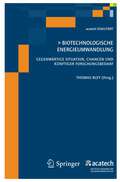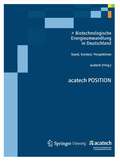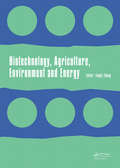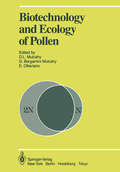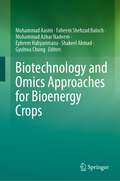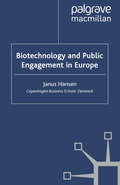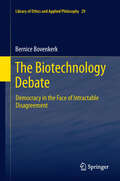- Table View
- List View
Biotechnologies of Crop Improvement, Volume 3: Genomic Approaches
by Satbir Singh Gosal Shabir Hussain WaniDuring the past 15 years, cellular and molecular approaches have emerged as valuable adjuncts to supplement and complement conventional breeding methods for a wide variety of crop plants. Biotechnology increasingly plays a role in the creation, conservation, characterization and utilization of genetic variability for germplasm enhancement. For instance, anther/microspore culture, somaclonal variation, embryo culture and somatic hybridization are being exploited for obtaining incremental improvement in the existing cultivars. In addition, genes that confer insect- and disease-resistance, abiotic stress tolerance, herbicide tolerance and quality traits have been isolated and re-introduced into otherwise sensitive or susceptible species by a variety of transgenic techniques. Together these transformative methodologies grant access to a greater repertoire of genetic diversity as the gene(s) may come from viruses, bacteria, fungi, insects, animals, human beings, unrelated plants or even be artificially derived. Remarkable achievements have been made in the production, characterization, field evaluation and commercialization of transgenic crop varieties worldwide. Likewise, significant advances have been made towards increasing crop yields, improving nutritional quality, enabling crops to be raised under adverse conditions and developing resistance to pests and diseases for sustaining global food and nutritional security. The overarching purpose of this 3-volume work is to summarize the history of crop improvement from a technological perspective but to do so with a forward outlook on further advancement and adaptability to a changing world. Our carefully chosen “case studies of important plant crops” intend to serve a diverse spectrum of audience looking for the right tools to tackle complicated local and global issues.
Biotechnologische Energieumwandlung: Gegenwärtige Situation, Chancen und künftiger Forschungsbedarf (acatech DISKUTIERT)
by Th. BleyWas kommt nach den fossilen Energieträgern? Wie ist der Einsatz von Biomasse für die Energiegewinnung zu bewerten? Der Band versammelt ausgewählte Diskussionsbeiträge eines von der Deutschen Akademie der Technikwissenschaften (acatech) im Herbst 2008 veranstalteten Workshops. Im Mittelpunkt der Diskussion stehen die Energieträger Bioethanol und Biogas sowie Algen und Pflanzen als regenerative Energiequellen – insbesondere mit Blick auf den Beitrag, den die Biotechnologie leisten kann.
Biotechnologische Energieumwandlung in Deutschland: Stand, Kontext, Perspektiven (acatech POSITION #2)
by AcatechBis 2022 wird Deutschland aus der Kernkraft aussteigen und das Energiesystem zum Teil auf erneuerbare Energien umstellen. Neben Sonnenenergie und Windkraft nimmt dabei die Biomasse einen zentralen Platz ein: Mehr als zwei Drittel der heute bereitgestellten erneuerbaren Energie werden aus Biomasse gewonnen. In der regenerativen Wärme- und Kraftstoffversorgung ist Biomasse der Hauptenergieträger. Ein Verfahren, um aus Biomasse speicherbare Energie zu gewinnen, ist die biotechnologische Energieumwandlung. Die vorliegende POSITION hebt deren Bedeutung aus anwendungs- und verfahrenstechnischer Sicht heraus. Sie zeigt, wie die biotechnologische Energieumwandlung insbesondere dann einen herausragenden Beitrag zur Versorgungssicherheit in Deutschland und zur Reduktion von Treibhausgasemissionen leisten kann, wenn Nachhaltigkeitskriterien angelegt werden – und dass sich in diesem Feld gerade für Deutschland bedeutende Wertschöpfungsmöglichkeiten eröffnen.
The Biotechnologists: and the Evolution of Biotech Enterprises in the USA and Europe
by Stephanie JonesIn The Biotechnologists, a series of outstanding biotechnology entrepreneurs - from the USA, the UK and continental Europe - tell their own stories of how they played a part in the evolution of the biotechnology companies they founded and/or now run. The book also looks at the role of venture capital and other forms of financing through their key stages of growth. A detailed introduction outlines the emergence of the biotech boom and its progress to date. A glossary explains scientific terms.
Biotechnology: A Comprehensive Training Guide for the Biotechnology Industry
by Syed Imtiaz Haider Anika AshtokAll manufacturing companies face the daunting task of designing an employee training matrix that meets the gamut of national and international regulatory standards. Answering the call for a one-stop training resource that focuses exclusively on this multi-faceted, high-tech industry, Biotechnology: A Comprehensive Training Guide for the Biotechnolo
Biotechnology: A Hope or a Threat? (International Labour Office)
by Michael Lipton Iftikhar AhmedInvestigates current applications of biotechnology in developing countries and their impact on the rural poor. Can biotechnologies be specifically designed and deliberately released to alleviate rural poverty, or will they accentuate existing inequalities?
Biotechnology 101 (Science 101)
by Brian R. ShmaefskyWhat should the average person know about science? Because science is so central to life in the 21st century, science educators and other leaders of the scientific community believe that it is essential that everyone understand the basic concepts of the most vital and far-reaching disciplines. Biotechnology 101 does exactly that. This accessible volume provides readers - whether students new to the field or just interested members of the lay public - with the essential ideas of biotechnology using a minimum of jargon and mathematics. Concepts are introduced in a progressive order so that more complicated ideas build on simpler ones, and each is discussed in small, bite-sized segments so that they can be more easily understood.This short volume will enable students and lay people to understand the basics of one of the most important scientific fields of endeavor for the future.
Biotechnology, Agriculture, Environment and Energy: Proceedings of the 2014 International Conference on Biotechnology, Agriculture, Environment and Energy (ICBAEE 2014), May 22-23, 2014, Beijing, China.
by Fangli ZhengThe 2014 International Conference on Biotechnology, Agriculture, Environment and Energy (ICBAEE 2014) was held May 22-23, 2014 in Beijing, China. The objective of ICBAEE 2014 was to provide a platform for researchers, engineers, academics as well as industry professionals from all over the world to present their research results and development act
Biotechnology and Bioactive Polymers
by Charles E. Carraher Jr. C. G. GebeleinSome have predicted that the coming several decades will be the decades of "biotechnology," wherein cancer, birth defects, life span increases, cosmetics, biodegradation, oil spills and exploration, solid waste disposal, and almost every aspect of our material life will be affected by this new area of science. There will also be an extension of emphasis on giant molecules: DNA, enzymes, polysaccharides, lignins, proteins, hemoglobin, and many others. Biotechnology has been defined in various ways. In one sense, this field is older than human history and references to the human use of biotechnology-derived materials can be found in the oldest human writings, such as the Bible. In this book, biotechnology refers to the direct usage of naturally occurring materials or their uses as a feedstock, including the associated biological activities and applications of these materials. Bioactive polymers, on the other hand, are polymers which exert some type of activity on living organisms. These polymers are used in agriculture, controlled release systems, medicine and many other areas. The papers in this book describe polymers which essentially combine features of biotechnology and bioactivity.
Biotechnology and Biochemical Engineering: Select Proceedings of ICACE 2015
by Prasanna B. D. Sathyanarayana N. Gummadi Praveen V. VadlaniThis book serves to highlight the seamless integration of the sciences leading to sustainable technologies. Chemical engineering is one of the major disciplines catering to the societal needs in the fields of energy, environment and materials. The chapters of this book have been selected to encompass the latest in industrial biotechnology and biochemical engineering principles and applications. The chapters are included here after careful review for content and depth. The book focuses on the relatively new areas of molecular biotechnology and nanotechnology which have a strong impact at the fundamental and process levels in chemical engineering. The book also covers analytical procedures, experimental techniques and process analysis in bioprocessing, bioremediation, green separation methods, and emerging nanoparticle applications. It should be useful to students, academicians, and practitioners alike.
Biotechnology and Bioforensics: New Trends (SpringerBriefs in Applied Sciences and Technology)
by Amit KumarThis Brief covers broad areas of Applied Biology specifically into the domains of Biotechnology/Biomedicine and Forensic Science. Chapters included here would also explain the role of bioinformatics in protein and gene characterization, modeling of the protein structure, survey related to the chromosomal effect on Human Disorders like Diabetes and Cardiac Problems. This Brief is full of Innovative Literature like Use of Microbes in Electricity Production, Brain connection to Type 2 Diabetes etc. Interesting issues in Forensic biology and the aspects of Bioforensics like STR profiling of exhumed bones makes this brief truly useful and informative for Researchers. It also includes the advancements and new ideologies in understanding crop improvements & crop quality. This Brief witnesses Innovative Research related to the Bio and Agri software development too which are capable of accelerating Insilico biological data analysis.
Biotechnology and Ecology of Pollen: Proceedings of the International Conference on the Biotechnology and Ecology of Pollen, 9–11 July, 1985, University of Massachusetts, Amherst, MA, USA
by David L. Mulcahy Gabriella Bergamini Mulcahy Ercole OttavianoIn Recognition of the Forgotten Generation D. L. MULCAHyl Pollen was long believed to serve primarily a single function, that of delivering male gametes to the egge A secondary and generally overlooked value of pollen is that it serves to block the transmission of many defective alleles and gene combinations into the next generation. This latter function comes about simply because pollen tubes carrying defective haploid genotypes frequently fail to complete growth through the entire length of the style. However, the beneficial consequences of this pollen selection are diluted by the fact that the same deleterious genotypes are often transmitted through the egg at strictly mendelian frequencies (Khush, 1973). Gene expression in the pollen might thus at least appear to be a phenomenon of trivial consequence. Indeed, Heslop-Harrison (1979) rightly termed the gametophytic portion of the angiosperm life cycle, the "forgotten generation." This neglect, however, came about despite subtle but constant indications that pollen is the site of intense gene activity and selection. For example, Mok and Peloquin (1975) demonstrated that relatively heterozygous diploid pollen shows heterotic characteristics whereas relatively homozygous diploid pOllen does not. This was proof positive that genes are expressed (that is, transcribed and translated) in the pollen. 1 Department of Botany, University of Massachusetts Amherst, MA 01003, USA viii However, the implications for pollen biology of even this recent and well known study were not widely recognized.
Biotechnology and Genetics in Fisheries and Aquaculture
by Andy Beaumont Pierre Boudry Kathryn HoareFollowing the extremely well-received structure of the first edition, this carefully revised and updated new edition now includes much new information of vital importance to those working and researching in the fisheries and aquaculture industries. Commencing with chapters covering genetic variation and how it can be measured, the authors then look at genetic structure in natural populations, followed by a new chapter covering genetics in relation to population size and conservation issues. Genetic variation of traits and triploids and the manipulation of ploidy are fully covered, and another new chapter is included, entitled 'From Genetics to Genomics'. The book concludes with a chapter covering the impact of genetic engineering in aquaculture. With the inclusion of a wealth of up-to-date information, new text and figures and the inclusion of a third author, Pierre Boudry, the second edition of Biotechnology and Genetics in Fisheries and Aquaculture provides an excellent text and reference of great value and use to upper level students and professionals working across fish biology, aquatic sciences, fisheries, aquaculture, genetics and biotechnology. Libraries in all universities and research establishments where biological sciences, fisheries and aquaculture are studied and taught should have several copies of this excellent new edition on their shelves. Completely updated, revised and expanded new edition Subject area of ever increasing importance Expanded authorship Commercially useful information for fish breeders
Biotechnology and Genetics in Fisheries and Aquaculture
by Andy Beaumont K. HoareThe recent development of molecular biology and genetic techniques, in particular those that are increasingly being used in practical situations in fish biology, fisheries and aquaculture, has led to a gap in the understanding by many of the science behind these techniques and their correct implementation for maximum results. The authors of this important book, Andy Beaumont and Kate Hoare, have written a text of great clarity, which carefully explains the science and application of molecular and genetic techniques to fisheries and aquaculture situations and what these new technologies have to offer. Contents include a full explanation of genetic variation and its measurement, genetic structure in natural populations, genetics and artificial selection in the hatchery, ploidy manipulation and the use of genetic engineering in aquaculture. Biotechnology and Genetics in Fisheries and Aquaculture is of great use to biological sciences students, particularly those studying marine, freshwater and aquatic biology, fish biology, fisheries, aquaculture, population biology and genetics. The book is also extremely useful as a reference to personnel such as fish farmers and fisheries scientists and all those working in fisheries and aquaculture management and research. Libraries in all universities and research establishments where biological sciences, fisheries and aquaculture are studied and taught should have copies of this book on their shelves.
Biotechnology And The New Agricultural Revolution
by Joseph J MolnarThe advent of new methods in shaping the performance characteristics of plants, animals, and microbes dramatically expands the possibilities for advances in agriculture -- a new "Green Revolution" in the offing. This book examines the impact of such developments on agricultural institutions, agribusiness, and farmers: What happens when a fundamenta
Biotechnology And The New Agricultural Revolution
by Joseph J MolnarThe advent of new methods in shaping the performance characteristics of plants, animals, and microbes dramatically expands the possibilities for advances in agriculture -- a new "Green Revolution" in the offing. This book examines the impact of such developments on agricultural institutions, agribusiness, and farmers: What happens when a fundamenta
Biotechnology and Omics Approaches for Bioenergy Crops
by Muhammad Aasim Faheem Shehzad Baloch Muhammad Azhar Nadeem Ephrem Habyarimana Shakeel Ahmad Gyuhwa ChungThis edited book summarizes the efforts made to develop sustainable bioenergy production through different generations. The topics included in the book cover information about different bioenergy crops, their classification and use as biofuel, agronomic practices to improve biomass yield, classic breeding techniques, genetic diversity, current status and future perspective of bioenergy crops in the omics era. It also discusses application of modern biotechnological and molecular biotechnological techniques for the improvement of bioenergy crops this having enhanced biomass and plant based products. The book explores growing biofuel crops and their impact on environment, bioethics and biosafety issues related to the modern approaches. Another important aspect is the incorporation of nanotechnology for bioenergy crops and biofuel production. All book chapters are contributed renowned researchers in their respective field. This is a unique book covering the bioeneragy crops in the modern omics era. The book is useful for the researchers and post-graduate students to guide them in the field of bioenergy crops.
Biotechnology and Polymers
by C. G. GebeleinThe term biotechnology has emerged on the contemporary scene fairly recently, but the basic concept of utilizing natural materials, either directly or in modified versions, dates back to antiquity. If we search the ancient literature, such as the Bible, we find hundreds of examples wherein people employed, or modified, natural materials for a variety of important uses. As far back as the days of Noah we find pitch, a natural material, being used as a caulk. Clothing was made from animal skins and the products of several plants. Today, we would consider these things as important biotechnological developments. Likewise, the human use of polymeric materials also has a long his tory. In fact, many of the original materials used by mankind were poly mers derived from nature, such as wood, flax, cotton, wool and animal skins, which were used for shelter and clothing. In recent years, however, the concept of biotechnology has taken on a new and renewed role in our society. This is due to a combination of factors, including an increased interest in environmental concerns and the desire to break free from the stranglehold that petrochemicals have placed on our society. If we can manufacture some of our polymers from renewable resources, then we can expect to prepare them for many more years into the future than we might if we could only depend on the petro chemical resources.
Biotechnology and Public Engagement in Europe
by J. HansenProviding a comparison the most important instances of public engagement with biotechnology in Europe in recent years, this book provides a theoretically reflected and empirically grounded study of the opportunities and obstacles for a thorough democratization of technological development through processes of public engagement.
Biotechnology and Sustainable Agriculture 2006 and Beyond: Proceedings of the 11th IAPTC&B Congress, August 13-18, 2006 Beijing, China
by Zhihong Xu Jiayang Li Yongbiao Xue Weicai YangThis timely work is a collection of papers presented at the XIth international congress of the International Association of Plant Tissue Culture & Biotechnology. It continues the tradition of the IAPTC&B in publishing the proceedings of its congresses. The work is an up-to-date report on the most significant advances in plant tissue culture and biotechnology as presented by leading international scientists. It will be crucial reading for agricultural scientists, among others.
Biotechnology Applied to Inflammatory Diseases: Cellular Mechanisms and Nanomedicine (Interdisciplinary Biotechnological Advances)
by Daniele Ribeiro de Araujo Marcela Sorelli Carneiro-RamosBiotechnology involves an interdisciplinary science that provides an interface between biological, molecular and cellular aspects of living organisms with broad technologies applicable in the fields of health, environment and materials. This book “Biotechnology applied to inflammatory diseases: Cellular mechanisms and nanomedicine” is focused on elaborating especially on two trendy areas from Biotechnology. In this volume, different inflammatory pathologies in terms of cellular and molecular mechanisms are characterized to better understand the science behind current precision medicine. The second part of the book focuses on the main biotechnological advancements for the understanding of the molecular mechanisms involved in the progression of various types of inflammatory diseases, highlighting up-to-date contributions of nanomedicine. The reader will be able to explore the utilization of technologies for various inflammatory diseases and will be able to enable an engaging and valuable knowledge for further research and clinically applied scenarios.
Biotechnology Business - Concept to Delivery (EcoProduction)
by Arpita SaxenaThis book is an effort to foster the entrepreneurial spirit in young minds. It reviews a wide range of product ideas, opportunities and challenges associated with start-ups. In addition, it discusses popular molecular targets for biotechnology research / the biotech industry such as attenuated microbes, gene sequences, biomarkers, and the latest advance in the sector, CRISPR. These molecular targets can be modified for the production of sufficient quantities of food and fuel. Very often, researchers limit their focus to the proof of concept, and fail to successfully convert it into a finished product. To help young entrepreneurs avoid this pitfall, the book addresses various aspects like intellectual property regulations, commerce and management. The book’s contributing authors hail from various specialized sectors, and from around the globe. Taken together, the respective chapters are intended to overcome the borders between disciplines that otherwise rarely interact.
The Biotechnology Debate: Democracy in the Face of Intractable Disagreement (Library of Ethics and Applied Philosophy #29)
by Bernice BovenkerkThis book grounds deliberative democratic theory in a more refined understanding of deliberative practice, in particular when dealing with intractable moral disagreement regarding novel technologies. While there is an ongoing, vibrant debate about the theoretical merits of deliberative democracy on the one hand, and more recently, empirical studies of specific deliberative exercises have been carried out, these two discussions fail to speak to one another. Debates about animal and plant biotechnology are examined as a paradigmatic case for intractable disagreement in today’s pluralistic societies. This examination reveals that the disagreements in this debate are multi-faceted and multi-dimensional and can often be traced to fundamental disagreements about values or worldviews. “One of the acute insights to emerge from this examination is that deliberation can serve different purposes vis-à-vis different types of problem. In the case of deeply unstructured problems, like the modern biotechnology debate, the aim of inclusion is more appropriate than the aim of consensus. This book highlights the importance of political culture and broader institutional settings in shaping the capacity and propensity of citizens to engage in deliberation and the degree to which governments are prepared to relinquish authority to deliberative mini-publics."Robyn Eckersley, University of Melbourne, Australia
Biotechnology, Education and Life Politics: Debating genetic futures from school to society (Routledge Research in Education)
by Pádraig MurphyWhat should individuals and society do when genetic screening becomes widely available and with its impact on current and future generations still uncertain? How can our education systems around the world respond to these developments? Reproductive and genetic technologies (RGTs) are increasingly controversial and political. We are entering an era where we can design future humans, firstly, by genetic screening of "undesirable" traits or indeed embryos, but perhaps later by more radical genetic engineering. This has a profound effect on what we see as normal, acceptable and responsible. This book argues that these urgent and biopolitical issues should be central to how biology is taught as a subject. Debate about life itself has always been at the forefront of connected molecular, genetic and social/personal identity levels, and each of these levels requires processes of communication and debate, what Anthony Giddens called in passing life politics. In this book Pádraig Murphy opens the term up, with examples from field research in schools, student responses to educational films exploring the future of RGTs, and science studies of strategic biotechnology and the lab practices of genetic screening. Life political debate is thoroughly examined and is identified as a way of connecting mainstream education of biology with future generations. Biotechnology, Education and Life Politics will appeal to post-graduates and academics involved with science education, science communication, communication studies and the sociology of education.
Biotechnology, Education and Life Politics: Debating genetic futures from school to society (Routledge Research in Education)
by Pádraig MurphyWhat should individuals and society do when genetic screening becomes widely available and with its impact on current and future generations still uncertain? How can our education systems around the world respond to these developments? Reproductive and genetic technologies (RGTs) are increasingly controversial and political. We are entering an era where we can design future humans, firstly, by genetic screening of "undesirable" traits or indeed embryos, but perhaps later by more radical genetic engineering. This has a profound effect on what we see as normal, acceptable and responsible. This book argues that these urgent and biopolitical issues should be central to how biology is taught as a subject. Debate about life itself has always been at the forefront of connected molecular, genetic and social/personal identity levels, and each of these levels requires processes of communication and debate, what Anthony Giddens called in passing life politics. In this book Pádraig Murphy opens the term up, with examples from field research in schools, student responses to educational films exploring the future of RGTs, and science studies of strategic biotechnology and the lab practices of genetic screening. Life political debate is thoroughly examined and is identified as a way of connecting mainstream education of biology with future generations. Biotechnology, Education and Life Politics will appeal to post-graduates and academics involved with science education, science communication, communication studies and the sociology of education.

